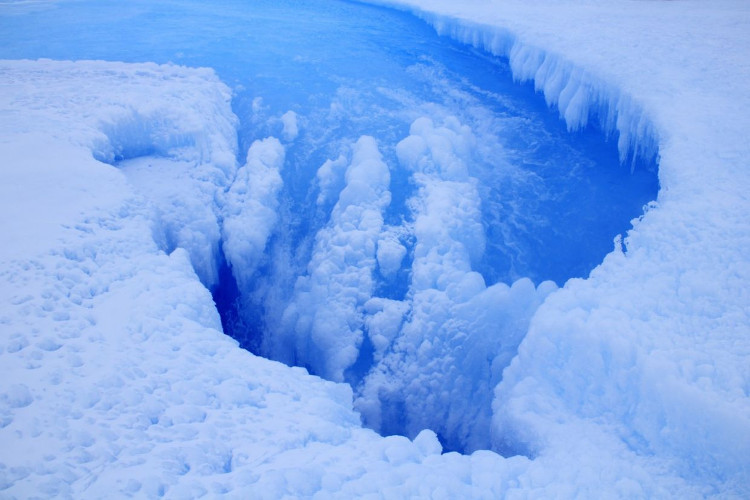The largest ice hole ever appeared in the east of Antarctica
This is the largest ice hole discovered so far. Ice holes appear to show that a large amount of ice has melted and pushed global sea levels to high levels in the future.
The newly discovered ice hole is located in the King Baudoin ice shelf of the east coast of Antarctica. This ice hole is not new, it has been observed through satellite imagery since 1989, but this discovery was surprised by its large size.
Many believe that a meteorite crashed into the area in 2004, but scientists do not think so. They said that it was possible that the underground ice sheets had melted, causing the ice on the surface to sink, forming such a wide-band hole.

A 2km wide pit forms a lake on the surface of the iceberg in eastern Antarctica.There are liquid water flows in here.(Photo: Sanne Bosteels).
Scientist Stef Lhermitte and his team found that the crater had moved about 400km from its original position when discovered. Lhermitte's group was the first group to actually explore this crater.
According to the initial observation, the ice hole was about 3m deep. Inside, there are three longitudinal slots lying parallel and forming two glaciers in the center of the ice hole.
"Looking at the ice hole, we can think of it as a collapsed lake. There are glaciers still flowing on the lake, which shows that it has melted below , " Lhermitte said.
The problem is that these flows have never been seen in the former Antarctic ice shelves. These flows appear only in Greenland, while in Antarctica it is too cold to appear flows.
"This is a big surprise. We have never seen flows with water flowing on cold ice all year round," Lhermitte explained, adding that the flow of Antarctic currents is a real no-no. often.
Lhermitte's team now begins to understand why liquid water flows may appear in a frozen year-round area. According to them, this may be the result of global warming.
The katabatic winds blew, in the direction from the center of the King Baudoin ice shelf, toward the ice hole at 35 km / h. These winds carry warm, dry air, causing the ice surface to melt.

Another liquid lake is located between the lake on the surface and the ice below.(Photo: Stef Lhermitte).
When the surface dissolves partially, the ice becomes thinner, making the lower layers of ice year-round submerged in darkness, exposed to the sun and dissolved from the inside, collapsing, forming a lake wide on the surface.
"When the surface forms a large lake will increase the surface pressure on the lower part and make the lower layers continue to melt into water," said co-author Jan Lenaerts, co-author of the study. : "We must quickly find the cause of the crater, make sure that it is not a pit caused by meteorites, but caused by global warming. people about climate change ".
When the research team drilled down below the lake, they found another lake between the lake surface and the ice layers below. This shows that an area of the middle ice has melted and formed a liquid water space.
"A huge amount of liquid water is being kept inside Antarctic ice sheets. If climate change continues to deteriorate, the outer layers of ice will melt to sea level all over. Demand suddenly increased, threatening millions of people living in coastal areas, " Lenaerts said in a press release.
The study is published in Nature Climate Change.
- Scientists split about the huge gap that appeared in Antarctica
- Ozone holes in Antarctica: can not be predicted
- The ozone gap in Antarctica is the smallest in nearly 3 decades
- The giant death hole appeared in Thanh Hoa
- The world's largest iceberg is at risk of breaking away from Antarctica
- Ozone hole ... is shrinking
- The mysterious death hole appeared in Russia
- New discovery of the ozone layer gap in Antarctica
- 4 scenario is happening when the largest iceberg in history has just broken in Antarctica
- The wall is 20 meters across the largest freshwater lake in the Far East
- From 'death pit' in Thanh Hoa discovered caster cave
- Fossils reveal Antarctica warmer than in the past
 Is the magnetic North Pole shift dangerous to humanity?
Is the magnetic North Pole shift dangerous to humanity? Washington legalizes the recycling of human bodies into fertilizer
Washington legalizes the recycling of human bodies into fertilizer Lightning stone - the mysterious guest
Lightning stone - the mysterious guest Stunned by the mysterious sunset, strange appearance
Stunned by the mysterious sunset, strange appearance